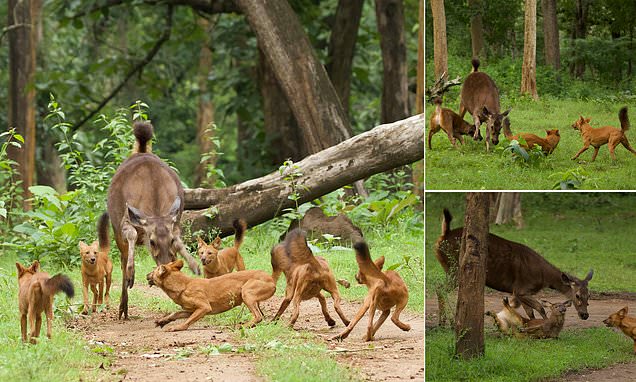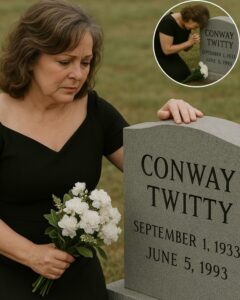A mother deer in India showed powerful courage when a pack of six wild dogs targeted her young fawn. In the Kabini forest of Karnataka, a photographer captured the tense scene as the mother stood her ground. It was a raw moment from nature, where animals fight to survive and protect their families in a wild habitat filled with both beauty and danger.
A moment that shows the wild as it is
Photographer Sriramulu Ravi Kumar, 52, from Bangalore, was documenting wildlife in Kabini when the action unfolded. He saw a female sambar deer facing down six wild dogs. The dogs worked together, circling and rushing in. The mother kept turning, stamping, and charging to keep them away from her baby. For a time, she held them off. Her eyes stayed fixed on the pack. Her body placed itself as a shield between the predators and the fawn.
This was not a staged scene. It was not a movie. It was life in the forest—fast, loud, and honest.
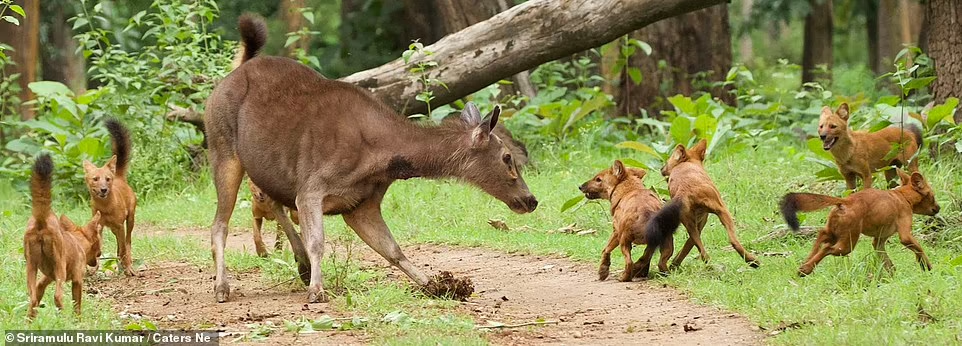
The place: Kabini forest, part of a larger habitat
Kabini forest sits within the Nagarhole National Park (also called Rajiv Gandhi Tiger Reserve). The area is known for rich wildlife: elephants, deer, leopards, tigers, otters, and many birds. Forest, grassland, and riverbanks make up a mosaic of habitats that support many animals. In a place like this, each day brings new risks and new chances. Prey must stay alert. Predators must work together. This balance is what keeps nature healthy, even when it feels harsh.
A mother’s instincts: why deer defend
Sambar deer are large, strong, and careful. Mothers keep their fawns close. They teach them to hide, to move quietly, and to read danger. When a threat comes, a mother deer often stands tall, stamps the ground, and uses sharp hooves to strike. She may lunge forward to push the attacker back. These moves buy time. Sometimes they are enough. Sometimes the pack is too many.
In Kabini that day, the mother deer did everything she could. She pushed, kicked, and turned again and again. The photographer recorded her effort with respect and sadness.
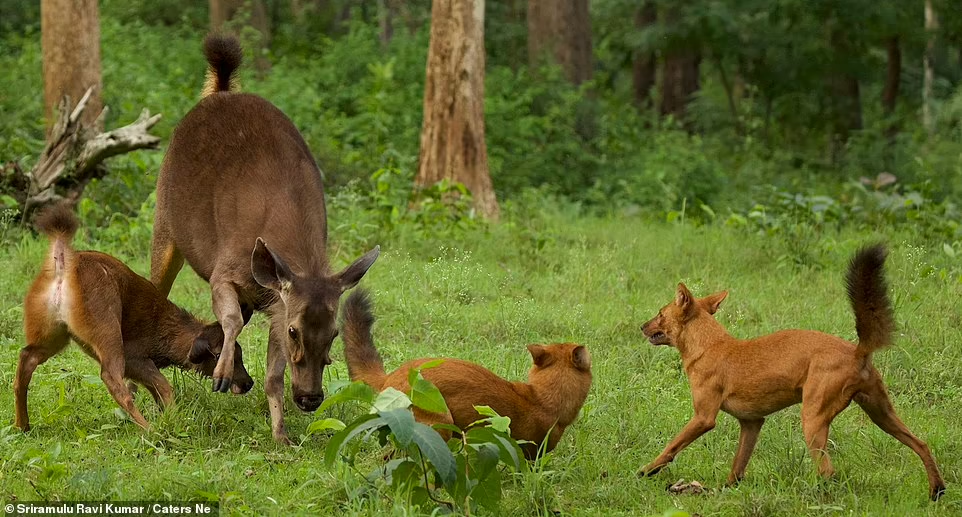
Why wild dogs hunt in packs
Wild dogs (also called dholes in parts of Asia) are smaller than sambar deer, but they are quick and highly social. Teamwork is their strength. They use sharp, forward-facing eyes to track movement. They spread out, test a herd, and look for weakness. One dog distracts; others rush in from the side. Short chases, sudden turns, and tight coordination can overwhelm larger prey.
This strategy is not “cruel” in an animal sense. It is how predators feed their young and keep their families alive. In the forest, survival is the rule for all—prey and predator alike.
The outcome and what it means
Despite the mother’s brave defense, the fawn did not survive. This is hard to read. It was hard for the photographer to watch. Yet scenes like this are part of a living ecosystem. The pack eats; the herd learns; the forest continues. Later, the mother will likely breed again. Sambar fawns spend their first two years under the care of their mothers. Those who grow strong help the herd remain stable.
We honor the mother’s courage without pretending the ending changed. Truth gives wildlife stories their power.
Reading bodies: how predators and prey see the world
-
Predators: Dogs have eyes set forward. This gives depth vision—good for chasing and judging distance.
-
Prey: Deer have eyes on the sides of their heads. This gives a wide view—good for spotting danger from many angles.
-
Size and strength: A mature sambar deer can stand around 60 inches at the shoulder and can be very heavy. Size helps in short bursts. But a pack’s speed and teamwork can split attention and break defenses.
These body differences are not accidents. They are long-term fits to each animal’s role in its habitat.
Why photographers document tough moments
Kumar released these images as part of a series on Kabini’s wildlife. Photos like these can be hard to share, but they teach. They show that the forest is not a theme park. It is a place where life and death are both present. Viewers learn to respect distance, follow rules, and support conservation. The more we see real nature, the more we value the land that keeps it alive.
Respecting the forest: how visitors can help
If you travel to parks or reserves, you can make choices that protect animals and their homes:
-
Keep your distance. Never crowd an animal for a photo. Use zoom, not feet.
-
Stay quiet and calm. Loud noise can stress herds and attract predators.
-
Follow guides and rules. Park staff know where animals move and how to avoid trouble.
-
Stay on marked tracks. This protects plants, nests, and hidden young.
-
Do not feed wildlife. Human food changes behavior and can make animals sick.
-
Support local conservation. Fees and donations help rangers guard the habitat.
What this story teaches
-
Courage is common in nature. The mother deer fought because that is what mothers do.
-
Teamwork is powerful. The dogs worked together because that is how they survive.
-
Balance matters. Healthy forests have both prey and predators. Both are needed.
These lessons are simple, but they shape every day in the wild.
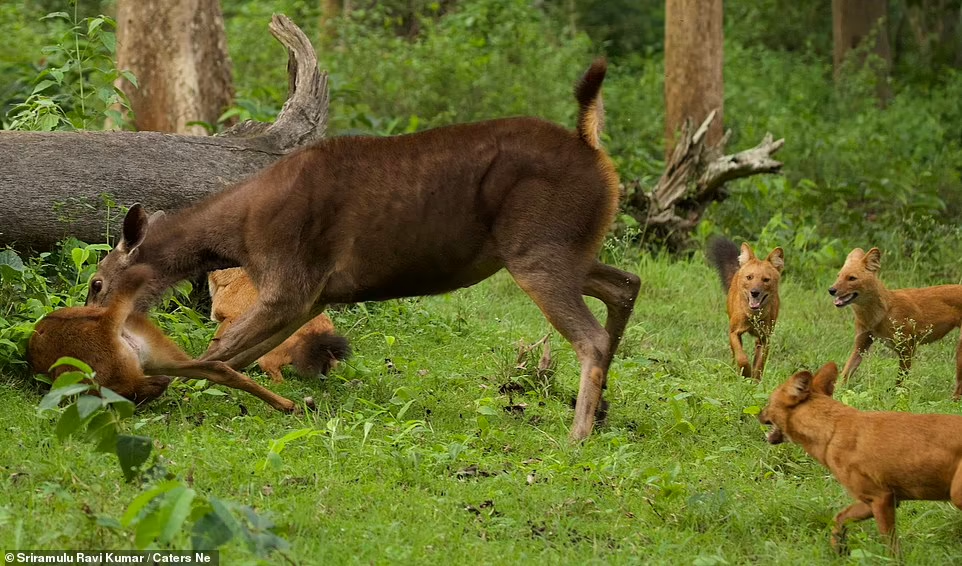
Quick facts: Sambar deer (easy to remember)
-
Range: Indian subcontinent, China, and Southeast Asia.
-
Size: Tall and heavy; strong legs and sharp hooves.
-
Young: Fawns hide often; mothers guard closely for up to two years.
-
Food: Leaves, grasses, and shrubs.
-
Role in nature: Important prey for large predators; help shape plant growth through grazing.
Quick facts: Wild dogs (general)
-
Social hunters: Move in packs; share food and care for pups.
-
Strategy: Test and tire prey; make quick, coordinated moves.
-
Eyesight: Forward-facing eyes for tracking moving targets.
-
Role in habitat: Keep herbivore numbers balanced; remove weak and sick animals.
Feeling deeply while thinking clearly
It is normal to feel sad when a fawn is lost. Feelings mean we care. Still, we can also think clearly about why these events happen. Predators are not villains. Prey are not helpless. Each has tools for life. When we protect the forest, we protect this honest, complex dance.
FAQs (clear and simple)
Q: Why didn’t the mother deer win against the dogs?
A: She was strong, but the pack was many. Packs use teamwork and speed to divide attention and wear prey down.
Q: Is it wrong to photograph such moments?
A: When done with distance and respect, photos help people understand real wildlife and support protection for their habitats.
Q: Are wild dogs common in Kabini?
A: Packs are seen in parts of the park. Sightings change with season, food, and movement of herds.
Q: What should visitors do if they see a hunt?
A: Stay in your vehicle, stay quiet, and follow the guide’s instructions. Do not move closer or interfere.
Q: How can I help deer and other animals?
A: Support parks, follow rules, reduce litter, and back groups that protect forests and water.
A final word
The mother deer in Kabini did not give up. She faced six wild dogs to guard her fawn. The result was painful, but the courage was real. Stories like this remind us to respect nature, care for habitats, and value the lives of all animals—prey and predator alike. The forest is honest. We should be, too.
Full Story: https://aquariumbee.com/man-loses-360-pounds-naturally-internet-rallies-to-support-his-next-step/
